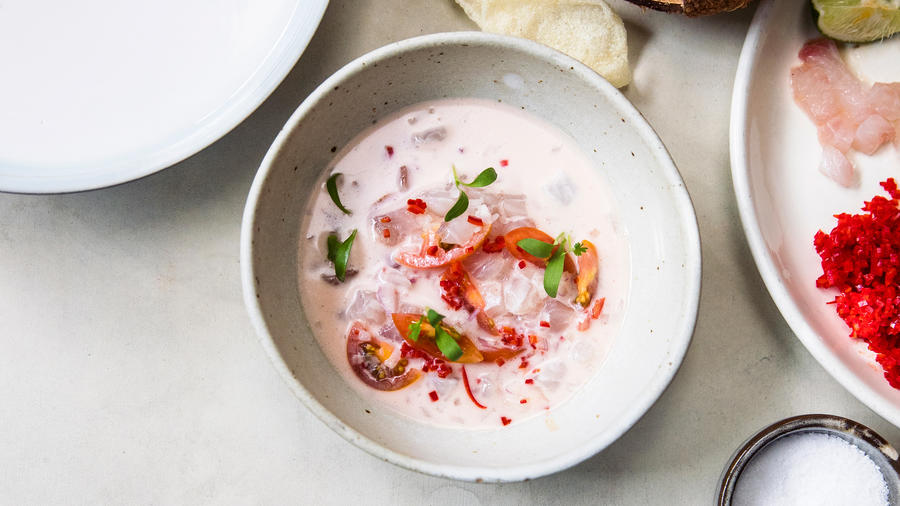Kokoda

In Fiji, says chef Louis Tikaram of E.P. & L.P restaurant, in Los Angeles, kokoda is eaten as part of the main course, but because good fish is so pricey in America, he serves it as a starter. Tikaram likes mild yet buttery Baja kanpachi (farmed amberjack), but it’s fine to use other, easier-to-find fish, like yellowtail, albacore tuna, mahimahi, or swordfish*.
How to Make It
Prep the fish: Pull or cut out any bones* and, if you like, trim away bloodlines (the darker red, stronger-tasting portions). “The Japanese leave the bloodline in. They like the meaty flavor against the more subtle, mild flavor of the rest of the fish,” says Tikaram. With a very sharp knife, slice the fish crosswise about 1/4 in. thick, then into 1/4-in. cubes. “I like to cut everything small. That way you get more of a flavor explosion of all the ingredients in every bite.” Chill fish until ready to serve.
Cut tomatoes lengthwise into thin wedges. Stem chile, then cut in half. Remove seeds and whitish ribs. Finely dice chile, enough to yield 1 tbsp. Finely dice enough shallot to yield 1 tbsp. as well.
In a bowl, mix fish with 1/2 tsp. salt and lime juice. “In Peruvian and Mexican ceviche, the fish is well cured in lime. Here, the lime is more of a seasoning, and the fish stays fresh and fragrant.” Then stir in tomatoes, chile, shallot, and coconut milk. Season with more salt or lime juice if you like.
Divide between 2 small bowls and top with cilantro. Serve immediately, with rice crackers, cassava chips, or root-vegetable chips.
*For swordfish that’s sustainable, look for fish caught with harpoons, handlines, or line-and- pole rigs; see seafoodwatch.org (search by fish name) for more info on sustainable-catch methods. For canned coconut milk, choose one without preservatives, like Native Forest Organic Coconut Milk, and dilute with 2 to 3 tbsp. water; to make fresh coconut milk, see “How to Crack and Milk a Coconut." Find Asian-style rice crackers and cassava chips (such as Maxi), which need to be fried before eating, at Asian markets. For boning fish, the best tool is a pair of fish tweezers (Kotobuki Japanese Fish Bone Tweezers, $5.50; amazon.com).
Ingredients
Directions
Prep the fish: Pull or cut out any bones* and, if you like, trim away bloodlines (the darker red, stronger-tasting portions). “The Japanese leave the bloodline in. They like the meaty flavor against the more subtle, mild flavor of the rest of the fish,” says Tikaram. With a very sharp knife, slice the fish crosswise about 1/4 in. thick, then into 1/4-in. cubes. “I like to cut everything small. That way you get more of a flavor explosion of all the ingredients in every bite.” Chill fish until ready to serve.
Cut tomatoes lengthwise into thin wedges. Stem chile, then cut in half. Remove seeds and whitish ribs. Finely dice chile, enough to yield 1 tbsp. Finely dice enough shallot to yield 1 tbsp. as well.
In a bowl, mix fish with 1/2 tsp. salt and lime juice. “In Peruvian and Mexican ceviche, the fish is well cured in lime. Here, the lime is more of a seasoning, and the fish stays fresh and fragrant.” Then stir in tomatoes, chile, shallot, and coconut milk. Season with more salt or lime juice if you like.
Divide between 2 small bowls and top with cilantro. Serve immediately, with rice crackers, cassava chips, or root-vegetable chips.
*For swordfish that’s sustainable, look for fish caught with harpoons, handlines, or line-and- pole rigs; see seafoodwatch.org (search by fish name) for more info on sustainable-catch methods. For canned coconut milk, choose one without preservatives, like Native Forest Organic Coconut Milk, and dilute with 2 to 3 tbsp. water; to make fresh coconut milk, see “How to Crack and Milk a Coconut." Find Asian-style rice crackers and cassava chips (such as Maxi), which need to be fried before eating, at Asian markets. For boning fish, the best tool is a pair of fish tweezers (Kotobuki Japanese Fish Bone Tweezers, $5.50; amazon.com).

